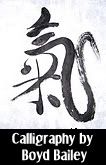How To Live 100 Years: Re-Learning to Breathe

The famous comedian George Burns was once asked, “What’s the secret of Life,” of which he replied, “keep breathing.” Wise words from a guy that reached the ripe ol’ age of 100 (and two months).
The Chinese symbol to the left is Qi (pronounced “chee”). We’ve heard it plenty… some of us have read up on it… but every one of us has experienced it [just most of us haven't been aware of it]. When I speak to youngsters about qi, I often allude to the Star Wars films in which George Lucas replaced “Qi” with “the Force.” Qi is a term that means energy, or breath. It is the prime-mover of our existence and permeates throughout the universe.
There are different types of “Qi Training” (called Qigong) such as: Buddhist Qigong, Taoist Qigong, Wushu Qigong and Medical Qigong. Within these, the practitioner learn to harness and cultivate this energy for the purposes of: emitting, absorbing, cleansing, conditioning and healing. [Author's note: Wushu Qigong should not be attempted without a qualified teacher. Practitioners should also have a basic understanding of qi and qigong training before wushu qigong is attempted]. And yes, there are even methods: Natural, Differential, Reversed, Dantian, Embryonic and “method of no-method.” All have their benefits but it is the first (Natural Breathing Qigon) that we will focus on for purposes of “beginning at the root”, health and in developing a habit of “correct method” of breathing throughout of days.
Breathing and its link to good health makes plenty of sense. …for it’s the air we breathe, the oxygen that is delivered to the cells and the energetics at work that nurtures life. But it’s our awareness of our breath through both moving or non-moving activities that bolsters results.
- Awareness: Concentrating on the “breath in” and the “breath out” focuses our mind internally and removes us from outside thoughts and common distractions. Thoughts will always enter in… it is just our nature as humans to think. But just as ripples appear on a pond… let the mind return to calm and think back to the breath as it is drawn into the body and finds its rest in the lower abdomen.
A MYTH: Healthy breathing does NOT mean expanding the chest and letting as much oxygen in as possible. By doing so, oxygen restricts the hemoglobin molecules and less is released to the cells.
THINK QUALITY OVER QUANTITY.
- Quality: Soft. Quiet. Relaxed. Smooth… all of these should be words to describe “how you are breathing. As you breath into your nostrils (at a relaxed, steady pace), imagine the breath going all the way down to your abdomen (aka. dantian). By bringing your breath to your dantian, even smallest blood vessels will relax and open and will enrich your body with a greater flow of blood, oxygen and qi.
- Natural or Diaphragmatic breathing:Breathe through the nose at a soft and steady rate and bring the breathe to the abdomen. Allow the abdomen to expand (by way of the breath, and not by your abdominal muscles pushing outwards). As you breathe out, do so by breathing out through the nose and allow the abdomen to contract/go inward.
- Relax: This cannot be repeated enough. The better you are at relaxing, the greater the benefits you will attain from your practice. Bring your thoughts away from school, work or any other outside distractions. If your thoughts drift… return back. Over time, over practice… the “return” will be easier and easier.
- Posture: There are many qigong postures and all of them will have to be adjusted slightly since we all are built differently. I have only 3 postures (which may be over simplified) and they are: standing, sitting and laying. I use each of these postures as throughout the day (as I am often in one of the 3 postures naturally). For instructional purposes, a standing posture should be made with a straight spine, head erect, knees slightly bent, arms by your side and the tip of the tongue resting softly behind the roof of the mouth (behind the first two teeth).

